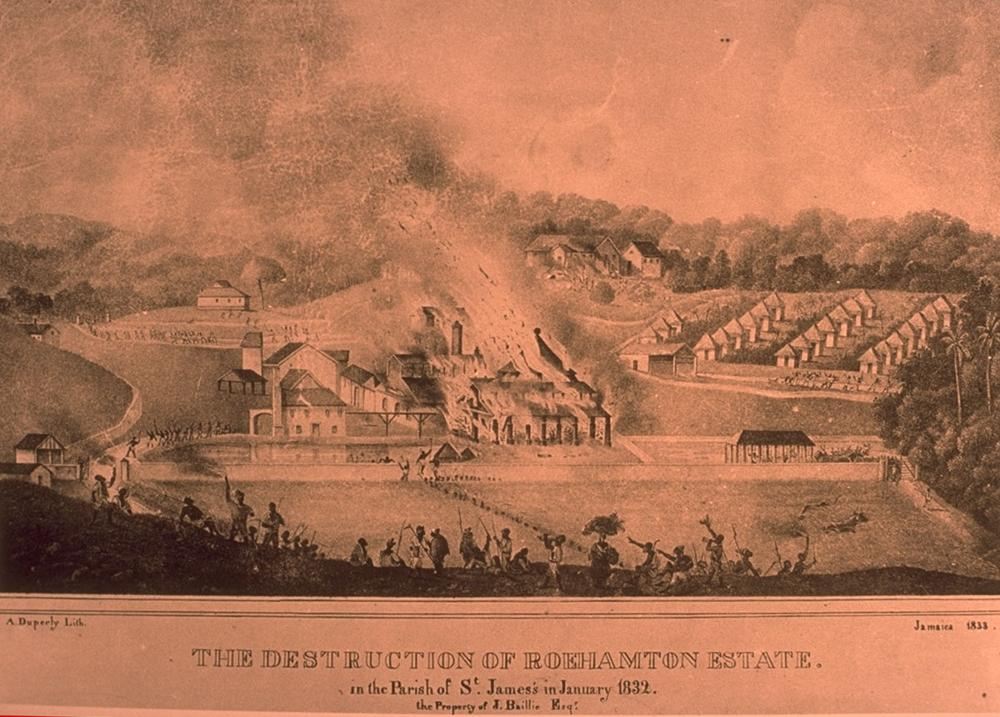
This Day in Labor History: December 23, 1831. The Baptist Rebellion began in Jamaica. This slave rebellion of up to 60,000 people, put down over the next couple of weeks, also was the final straw that moved the United Kingdom toward outlawing slavery in its colonies!!! 

By the early 1830s, the slave system in the British colonies was under attack from a number of fronts. First, there was a large abolitionist movement in Britain, led by William Wilberforce. This was known to slaves in the Caribbean.
Second, the British religious denominations had engaged in large-scale missions among the slaves in the previous decades.
In the United States, planters kept very tight control over slaves’ religious world, or at least as much as possible, with white preachers teaching subservience to the slaves on isolated plantations.
In the British colonies, this was less in the hands of individual planters and more concentrated in missionaries themselves. Presbyterians, Methodists, and Anglicans made up a lot of the missionaries, but so did Baptists and they had more success among the slaves in Jamaica.
In a nearly all-African descent society, very unlike the United States, certain classes of slaves could have more autonomy and given that there weren’t that many Baptist missionaries in Jamaica, the black deacons had a lot of ability to lead.
They would play a critical role in the rebellion.
Baptist minister Samuel Sharpe led the rebellion. Probably born in 1801 on a plantation in the Great River Valley, he likely had contact with some of the communities of free blacks who moved to Jamaica in the aftermath of the American Revolution.
A highly undertaught fact in American history is that both during the Revolutionary War and the War of 1812, thousands of slaves fled to British lines, helped the British raid plantations, and fought for the British, all in exchange for their emancipation.
Some of these now ex-slaves moved to Jamaica. This probably exposed Sharpe to emancipationist ideas from a young age. Many of these ex-slaves were Baptists and established congregations near the plantation where Sharpe lived. He eventually converted.
This was facilitated in part by Enlightenment-era plantation owners who tried to take the movement’s philosophic tenets seriously while also holding on to the investment in human property.
In response, they showed interest in moral and religious instruction for their slaves that didn’t really exist 50 years earlier. This was similar in what became the United States and religious instructions of slaves did not really happen before the Great Awakening in the 1740s.
Aware of the talk about slavery in Britain, Sharpe seems to believe that the British had already granted emancipation and the planters were refusing.
Although a slave, because he was a preacher, he had more leave to travel freely, which he used to spread his plans among various slave communities. After a prayer meeting in mid-December 1831, he and a selected group of followers met and made final plans.
He told them the history of other slave revolts in the Caribbean and then had them swear their faithfulness of the plans on the Bible. He and his followers demanded more freedom for black workers and a wage that was “half the going rate” of freed workers.
They decided to go on strike on Christmas to win these demands. They had some support by the island’s relatively small free white population, who were struggling economically due to a depression which they blamed on the control of the island by the planter elite.
They did not think this would lead to widespread suppression, but as it spread, the white Jamaican elites and the British cracked down hard.
The first stirrings of the strike started on Christmas Day, but turned into an active and full-fledged slave rebellion on December 27, when slaves set sugar on fire at the Kensington plantation near Montego Bay.
This quickly turned into a huge rebellion, as up to 60,000 of Jamaica’s 300,000 slaves actively participated. Sharpe himself had hoped this would go off peacefully, but had already laid the groundwork for armed resistance if it the planters started the violence.
The slaves began arming themselves and pitched battles broke out.
The slaves actually started burning the plantations before the strike had a chance to take full effect, as rumors about a crackdown were swirling and the panicked actions impossible for Sharpe or anyone else to control.
A black militia regiment known today only as the Black Regiment and led by a man named Johnson, about whom we know nothing else, defeated an armed white militia on December 28, freaking out the island’s white elites.
Overall, 14 whites were killed, as well as 207 slaves before the revolt was put down on January 4, 1832. However, continued resistance in the mountains went on for about two more months.
Another 300 or so slaves were executed, often for very small offenses, such as stealing a cow or pig, or just shot on sight. One of the executed was Samuel Sharpe, tried on April 19 and hanged on May 23, 1832.
Jamaican plantation owners blamed the missionaries for stirring up what were surely loyal slaves, amiright? But the brutality of the suppression helped push the British public over the top to end slavery entirely.
This received a lot of coverage in the British papers, much of it highly negative. Soon after, Parliament passed a law to start gradual emancipation in 1834 and total emancipation by 1838.
Samuel Sharpe is a national hero in Jamaica today. His face adorns the $50 Jamaican bill.
Back tomorrow to discuss the founding of the Knights of Labor in 1869.
• • •
Missing some Tweet in this thread? You can try to
force a refresh









